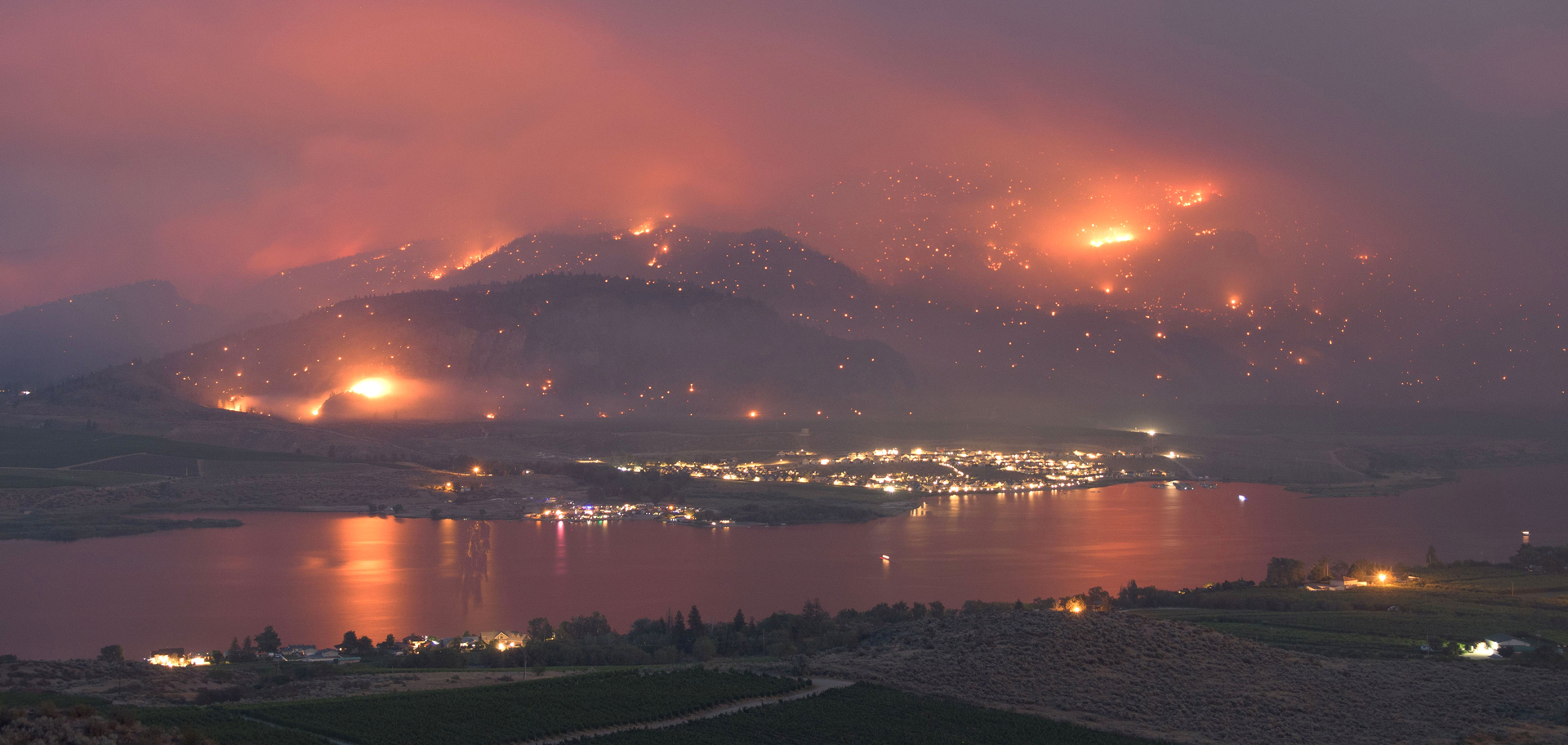
According to the World Health Organization, only 1% of the global population lives in areas where air quality meets its recommended guidelines. In other words, 99% of people worldwide breathe air that exceeds limits for pollutants like PM 2.5 and NO2, posing a health risk.
The term “air pollution,” according to the World Health Organization (WHO), is the contamination of the indoor or outdoor environment by any biological, chemical or physical agent that modifies the natural characteristics of the atmosphere. Forest fires, industrial facilities, motor vehicles and household combustion devices—such as clothes dryers, fireplaces, furnaces, ovens, stoves and water heaters—are common sources of air pollution. The pollutants carbon monoxide (CO), nitrogen dioxide (NO2), ozone, particulate matter (PM) and sulfur dioxide are some of the most concerning for public health.
Indoor and outdoor air pollution can cause respiratory and other diseases and are important sources of morbidity and mortality. And here’s the kicker: WHO data shows that almost all of the global population (99%) breathe air that exceeds WHO guideline limits and contains high levels of pollutants, with low- and middle-income countries suffering from the highest exposures.
Recently, I started thinking about air pollution when I read about a study done in Greenland, one of my favorite places on Earth. Past and present open-waste burning in Northwestern Greenland is affecting the nation’s air quality and calling attention to the need for air-quality monitoring in Arctic regions.

Ice cores from Greenland show that air pollution from burning fossil fuels reaches the remote Arctic in amounts large enough to alter its fundamental atmospheric chemistry. This provides support for having clean-air rules, which can reverse the effect.
All around the world, however, exposure to certain air pollutants—such as fine particulate matter (PM 2.5) and nitrogen oxides (NOx)—during pregnancy and childhood is associated with differences in the volume of the brain’s white matter, with implications for cognitive function, connections throughout the brain and even Alzheimer’s disease. And breathing polluted air—even at levels considered “safe”—may quietly damage your heart.
Continuous air-quality monitoring is needed in Greenland
Qaanaaq is one of the northernmost towns in the world. Within Greenland, it is the northernmost major town and the third northernmost public settlement, with a population of about 600. Here, the sun never makes it above the horizon for 3.5 months of the year (the “Polar Darkness”) and then never sets for five months over summer (known as the “Midnight Sun”). Qaanaaq is still a place where old-time traditions, such as hunting with dog sleds and kayaks, are common and necessary for survival.
In 2022, an international science team with the goal of better understanding the air-quality risks faced by remote Arctic communities monitored aerial pollutants in Qaanaaq.

Qaanaaq, Greenland, is small enough that the only time you need transport is to and from the airport. In summer, the most common way to get around is by boat; in winter, by dogsled or snowmobile. Otherwise, you just walk.
The scientists used advanced, commercially available measurement systems for cold regions to collect continuous PM 2.5 data spanning the period from July 20 to August 13, 2022. Particulate matter—especially smaller particles with a diameter of 2.5 microns or less—is extremely dangerous: exposure can lead to respiratory ailments such as asthma and bronchitis, cardiovascular diseases and even premature death.
The scientists’ analysis, published in the journal Atmospheric Science Letters in March 2024, uncovered multiple instances of heightened PM 2.5 levels, which were notable from August 8 onwards. The increases were attributed to local, open-waste burning activities, as evidenced by the visible black smoke emitted from the Qaanaaq dump site on the same days with the heightened PM 2.5 levels.
Monitoring PM 2.5 levels is important, say the researchers, for assessing air quality and protecting the public’s long-term health, including that of Arctic residents. Unfortunately, compared to the midlatitudes, PM 2.5 observations in high-latitude regions are far fewer. To combat the health risks to the Qaanaaq community during local, open-waste burning, the town now uses an incinerator.

Air quality in the Arctic is heavily influenced by local emissions and long-range transport of pollutants from industrialized areas, particularly Eurasia and North America. Air quality is better in summer—as here, in Arctic Norway—as opposed to winter because increased sunlight helps clear pollutants.
Limits to air-pollution exposures are warranted for developing brains
It’s not only Arctic residents who may have been left behind in air-pollution monitoring and research. An increasing amount of evidence suggests that the effects of air pollution make lasting marks on children’s neurodevelopment.
Recent studies using imaging techniques have looked at the impact of air pollutants on the brain’s white matter, which plays a critical role in connecting different brain regions. However, most of these studies were limited in that they only looked at one point in time and did not follow the participants throughout childhood. So, to shed new light on whether the effects of air pollution on white matter persist, attenuate or worsen, a research team from Spain’s Barcelona Institute for Global Health set up a study.
The more than 4,000 participants in the study have been followed since birth as part of the Generation R Study in the Netherlands. The research team estimated the amount of exposure to 14 different air pollutants during pregnancy and childhood, based on where the families lived. For 1,314 children, the researchers were able to use data from two brain scans—one performed around 10 years of age and another around 14 years of age—to examine changes in white-matter microstructure.

The Generation R Study is a population-based, prospective cohort study from fetal life until adulthood. The study is designed to identify early environmental and genetic causes that lead to abnormal and normal development and growth.
The analysis found that exposure to certain pollutants, like PM 2.5 and NOx, was linked to differences in the development of white matter in the brain. Specifically, higher exposure to PM 2.5 during pregnancy and higher exposure to PM 2.5, PM 10, PM 2.5–10 and NOx during childhood were associated with lower levels of fractional anisotropy, which measures how water molecules diffuse within the brain. In more mature brains, water flows more in one direction than in all directions, which gives higher values for this marker. This association persisted throughout adolescence (it was also observed in the second scan), suggesting a long-term impact of air pollution on brain development. Every increase in exposure level to air pollution corresponded to more than a five-month delay in the development of fractional anisotropy.
The researchers think that the lower fractional anisotropy is likely the result of changes in myelin, the protective sheath that forms around the nerves. How air pollutants affect myelin is not fully understood, but it could be linked to the entrance of small particles directly into the brain or to inflammatory mediators produced by the body when the particles enter the lungs. Together, this would lead to neuroinflammation, oxidative stress and eventually neuronal death, as documented in animal studies.
Some pollutants were linked to changes in another measure of white matter, called mean diffusivity, which reflects the integrity of white matter and tends to decrease as the brain matures. Higher exposure to pollutants, like silicon in fine particles, during pregnancy was associated with initially higher mean diffusivity, which then decreased more rapidly as the children grew older. This indicates that some effects of air pollution may diminish over time.

New, more ambitious, European air-quality standards are set to be achieved by 2030 for all major pollutants to make them more closely match the World Health Organization’s recommendations. The ultimate vision is for air pollution to have no significant impact on health by 2050.
Overall, the results of the study, which were published in the journal Environmental Research in December 2024, suggest that air-pollution exposure, both during pregnancy and early childhood, can have lasting effects on the brain’s white matter. Even if the size of the effects is small, this can have a meaningful impact on a population scale. Therefore, conclude the scientists, more stringent European guidelines on air pollution are required.
Europe, however, isn’t the only continent on the hook. Recently, a University of California, Davis, research team systematically analyzed 40 empirical studies from four continents—Asia, Australia, North America, as well as Europe—that all included measures of outdoor air pollution and brain outcomes for children at various ages, from newborns up to 18-year-olds. Almost all had found that outdoor air pollution is associated with differences in children’s brains.
This systematic review, published in the journal Developmental Cognitive Neuroscience in October 2024, proposed steps for both parents and policymakers to protect their children from outdoor air pollution by, for example, adding air filters to homes and schools near freeways. Researchers can also incorporate measures of air pollution into studies related to brain health or other health outcomes that collect data from human participants simply by obtaining participants’ addresses.

The combination of air pollution, dense urban development and limited green spaces increases the risk of asthma in both adults and children. Adding in green spaces—such as this one, in Central Park in New York City—when planning future urban environments would help protect public health.
Urban green spaces are required to combat asthma
Not only does air pollution increase brain problems in children, but it can also—along with dense urban development and limited green spaces—increase the risk of asthma.
In a new study led by researchers from Sweden’s Karolinska Institute, information on the home addresses of nearly 350,000 people of different ages from 14 cohorts in seven European countries made it possible to link data on various environmental risks in the urban environment to individual people. The environmental exposures included were air pollution, outdoor temperatures and the level of urban density. The assessment was partly based on satellite images showing gray, green or blue areas, i.e., where there were buildings, green spaces or water.
Previous studies have typically calculated the risk of one environmental factor at a time. Here, the scientists combined several environmental factors and described how together they affect the risk of developing asthma. They believe this provides a better picture, as life in a city usually involves exposure to several environmental risk factors at the same time.

Blue spaces are outdoor environments where water—such as lakes, ponds and fountains, like this one—is a central feature. They promote calm, encourage physical activity, foster social connections and reduce stress. Spending time in blue spaces can decrease anxiety and improve mental well-being.
During the study period, nearly 7,500 of the participants developed asthma as children or adults. The researchers found that 11.6% of asthma cases could be explained by the combination of air pollution, lack of green spaces and dense urban development. Or, to put it another way, in a favorable environment, approximately one in 10 people with asthma would not have developed the disease. While this method makes it possible to identify risk areas in existing urban places, it can also be used when planning future city environments. The scientists are now investigating how the risk of other diseases—such as COPD, diabetes, heart attacks and strokes—is affected by an individual’s exposome, or the totality of environmental exposures, from conception to death.
A reduction in air-pollution levels is essential for heart health
Poor air quality has often been linked to cardiovascular disease, the leading cause of death worldwide. However, to date, the underlying changes in the heart resulting from air-pollution exposure are unclear.
To understand what drives this increased risk at the tissue level, researchers from Canada’s University Health Network in Toronto and the University of Toronto used cardiac MRI, a noninvasive imaging technique, to quantify myocardial fibrosis and assess its association with long-term exposure to PM 2.5. To evaluate the effects of air pollution on both healthy people and those with heart disease, the study group included 201 healthy controls and 493 patients with dilated cardiomyopathy, a disease that makes it more difficult for the heart to pump blood.

Long-term exposure to air pollution is associated with early signs of heart damage. Fine particulate matter in the air—such as that from wildfire smoke—may contribute to diffuse myocardial fibrosis, a form of scarring in the heart muscle that can precede heart failure.
In a July 2025 article published in Radiology, a journal of the Radiological Society of North America, the researchers write that higher, long-term exposure to fine particulate air pollution was linked with higher levels of myocardial fibrosis in both the patients with cardiomyopathy and the controls, suggesting that myocardial fibrosis may be an underlying mechanism by which air pollution leads to cardiovascular complications. The largest effects were seen in women, smokers and patients with hypertension. Even modest increases in air-pollution levels appeared to have measurable effects on the heart.
Since this study suggests that air quality may play a significant role in changes to heart structure, potentially setting the stage for future cardiovascular disease, knowing a patient’s long-term air-pollution exposure history could help refine a heart-disease risk assessment. For instance, if an individual works outside in an area with poor air quality, health-care providers could incorporate that exposure history.
The researchers say that the air-pollution exposure levels of the patients in the study were below many of the global air-quality guidelines, reinforcing that there are no safe exposure limits. While there have been improvements in air quality in Canada and the United States over the past decade, we still have a long way to go.

If you routinely work outside in an area or occupation with poor air quality, your exposure history should be incorporated into any of your heart-disease risk assessments.
Indoor air-quality mandates for public buildings are imperative
Unfortunately, most countries do not have any legislated indoor air-quality (IAQ) standards for public spaces that address concentration levels of indoor air pollutants. So, in March 2024, a group of international experts from Australia’s Queensland University of Technology presented a blueprint for national IAQ standards for public buildings in an article in the journal Science.
The experts addressed setting standards for three, key indoor pollutants (carbon dioxide [CO2], CO and PM 2.5) and ventilation rate. To have practical value, they say, IAQ standards must be capable of being implemented by designing new buildings that are constructed, operated and maintained or retrofitted to meet the standards. While there would be a cost in the short term, the economic and social benefits to public health, productivity and well-being will likely far outweigh the monetary investments, say the experts. CO2 sensors are readily available and inexpensive, and should be used as proxies to effectively assess ventilation quality and to measure CO2 and pathogens during human occupancy in a public space.
Another key indicator of air quality the experts addressed is the amount of PM 2.5. They propose the WHO air-quality guidelines as a basis for indoor air-quality standards but with a one-hour averaging time, as the 24 hours of the WHO air-quality guidelines is much longer than people usually spend in public places. Mechanical ventilation systems should remove and dilute human-emitted and other indoor-generated pollutants at a higher rate than their production so that they would not accumulate in indoor air.

A LEED (Leadership in Energy and Environmental Design) Platinum-certified green building blends mixed-mode, mechanical ventilation systems with natural airflow through strategically placed windows for a continuous fresh-air supply.
The technologies for measuring ventilation already exist in most modern, mechanically ventilated buildings; but monitoring ventilation rates in terms of clean air delivered to the space requires considering the number of people and their activities in the space to ensure adequate IAQ. A practical ventilation standard could be air from outside (assumed to be clean), or clean, recirculated air to the entire occupied zone and with airflow not directed from one person to another.
Additional measures in support of ventilation, such as air cleaning and disinfection, could greatly reduce the need to increase the outdoor air supply, which carries a heavy energy demand. Filtering recirculated air is an effective way to reduce concentration of, and thus our exposure to, airborne particulate matter, allergens and pathogens.
Keeping clean air is vital
Air quality is closely linked to the Earth’s climate and ecosystems around the globe. Many of the drivers of air pollution—such as the combustion of fossil fuels—are also sources of greenhouse gas emissions. Reducing air pollution, therefore, offers a win-win strategy for both the climate and our health, lowering the burden of diseases attributable to air pollution, as well as contributing to the near- and long-term mitigation of climate change.

Wouldn’t it be nice if we were motivated to keep the Earth’s air clean just because it makes outdoor activities more pleasant?
Historically, landmark air-pollution events have catalyzed government action, leading to modern clean-air legislation. But wouldn’t it be nice if we were motivated enough to keep the Earth’s air clean just because it makes outdoor activities more pleasant?
Here’s to finding your true places and natural habitats,
Candy


































